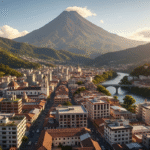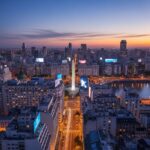
Oruro: The Heart of Bolivian Folklore – Travel Guide
- Information on how to contact the city’s tourist information center or municipality will be inserted here. (e.g., phone number, email, website)
Planning Your Oruro Trip: Essential Information
Bolivia at a Glance
- Country: Bolivia
- Time Zone: GMT -4
- Languages: Spanish, Quechua, Aymara
- Currency: Boliviano (BOB)
Oruro Weather and Climate: What to Expect
Knowing the weather in Oruro can greatly improve your experience. This high-altitude city experiences a distinct climate throughout the year.
- January-March: Rainy season. Expect cooler temperatures, averaging around 10-15°C (50-59°F). Be prepared for showers.
- April-May: Transition months. The weather becomes drier, with temperatures around 12-18°C (54-64°F). Pleasant for exploring.
- June-August: Dry season. The coldest months, with temperatures potentially dropping to 5-15°C (41-59°F). Nights can be freezing, so pack accordingly.
- September-November: Warmer and drier weather. Temperatures range from 15-22°C (59-72°F), making it a comfortable time to visit.
- December: Transition back to the rainy season. Temperatures are similar to January-March, with a chance of showers.
Discovering Oruro: A City Overview
Oruro, located high in the Bolivian Andes, is a city steeped in history and famous for its unique cultural traditions. Once a prominent mining hub, Oruro still holds a distinct historical charm, reflected in its architecture and overall vibe. Situated at an altitude of approximately 3,700 meters (12,000 feet) above sea level, the city boasts a distinctive landscape and a refreshing climate. However, Oruro is far more than just a relic of the past. It represents the enduring spirit of Bolivian folklore and artistry.
The heart of Oruro’s identity is its world-renowned Carnival, a UNESCO Masterpiece of the Oral and Intangible Heritage of Humanity. This magnificent event transforms the city into a captivating spectacle of music, dance, and intricate costumes, attracting visitors from all corners of the globe. Outside of Carnival, Oruro’s museums and historical sites provide insights into the region’s extensive mining legacy and pre-Columbian cultures. Although relatively small, Oruro delivers a fascinating glimpse into the heart and soul of Bolivia, seamlessly blending indigenous traditions with modern life. It is a must-visit destination for anyone looking for authentic cultural experiences.
Best Time to Visit Oruro: When to Go
Visiting During Carnival (February/March)
- Pros: Experience the globally recognized Carnival of Oruro, enjoy milder weather.
- Cons: Peak tourist season, higher prices for accommodations and tours, expect large crowds.
Visiting During the Dry Season (June-August)
- Pros: Fewer tourists, clear skies for photography, potentially ideal for outdoor activities around Oruro (though limited).
- Cons: Coldest temperatures, especially at night. Be prepared for freezing conditions.
Getting to Oruro: Transportation and Visa Requirements
How to Get There
- Flights: Oruro has Juan Mendoza Airport (ORU), but it primarily caters to domestic flights. Most international travelers fly into El Alto International Airport (LPB) in La Paz and then travel to Oruro by bus. Search for cheap flights to La Paz. (Affiliate Link to flight booking website if applicable).
- Trains: Train services connect Oruro to other Bolivian cities, including La Paz and Uyuni, but schedules can be infrequent. Check availability in advance.
- Airport Transfers: From La Paz airport to Oruro, buses are available from the La Paz bus terminal. The journey usually takes about 3-4 hours. Taxis are also an option, but they are substantially more expensive. Consider pre-booking a private transfer for convenience (Affiliate Link to transfer service if applicable).
Visa Information
- Visa Details: Visa requirements for Bolivia depend on your nationality. Always check the latest regulations on the Bolivian embassy or consulate website in your country before traveling. Ensure your passport is valid for at least six months beyond your intended stay.
Fun Fact: The Legend of the Diablada
The Carnival of Oruro’s famous Diablada (Dance of the Devils) is inspired by a legend about a bandit named Nina Nina, who was converted to Christianity by the Virgin of Socavón. The dancers’ costumes depict demons who are ultimately defeated by the forces of good, represented by Archangel Michael, illustrating the age-old battle between good and evil.
Famous Personalities from Oruro
While information is scarce regarding globally famous figures specifically *from* Oruro, the city has produced numerous influential Bolivian artists, musicians, and politicians who have contributed significantly to the country’s cultural and political landscape. Further research is recommended for specific names depending on your area of interest (e.g., Bolivian music, Bolivian politics).
Top 10 Oruro Attractions: What to See and Do
- Santuario del Socavón: The main church in Oruro, home to the Virgin of Socavón. The epicenter of the Carnival celebrations.
- Address: Oruro, Bolivia
- Museo Casa de la Cultura Simón Iturri Patiño: A museum dedicated to the life and legacy of Simón Iturri Patiño, one of Bolivia’s most significant tin magnates.
- Address: Soria Galvarro #360, Oruro, Bolivia
- Museo Mineralógico: Home to an extensive collection of minerals found in the Oruro region, a fascinating look at Bolivia’s geological wealth.
- Address: Av. del Ejército, Oruro, Bolivia
- Parque de la Unión Nacional: A central park in Oruro, perfect for a relaxing walk or enjoying the local atmosphere.
- Address: Oruro, Bolivia
- Teleférico Oruro: A cable car providing panoramic views of the city and the surrounding Andean landscape, great for photos.
- Address: Oruro, Bolivia
- Plaza 10 de Febrero: Oruro’s main square, surrounded by important government buildings and historical landmarks.
- Address: Oruro, Bolivia
- Museo Antropológico Eduardo López Rivas: A museum showcasing local anthropology and the region’s indigenous cultures.
- Address: Oruro, Bolivia
- Virgen del Socavón Monumental: A large statue of the Virgin Mary overlooking the city from Cerro Santa Bárbara, offering stunning views.
- Address: Cerro Santa Bárbara, Oruro, Bolivia
- Mercado Fermín López: A lively local market where you can find everything from fresh produce to clothing and souvenirs.
- Address: Oruro, Bolivia
- Minas de San José: Take a tour of the San Jose Mines and learn about the city’s mining heritage.
- Address: Oruro, Bolivia
Oruro’s Hidden Gems: Off the Beaten Path
- Balneario de Obrajes: A natural hot spring located a short distance from Oruro, offering a relaxing escape and therapeutic waters.
- Address: Obrajes, Oruro, Bolivia
- Local Markets Outside the City Center: Explore the smaller markets outside of the main city for a more authentic local experience.
- Address: Various locations outside the city center
Oruro Festivals and Events: Experience the Culture
- Carnaval de Oruro (February/March): The most famous event, a UNESCO-recognized festival featuring elaborate costumes, music, and dance performances. Plan your trip well in advance if you want to attend.
- Festival de la Virgen de la Candelaria (February): A religious festival celebrating the Virgin of Candelaria with processions and traditional dances.
Day Trips from Oruro: Exploring the Region
- Lake Poopó (approx. 2-3 hours): Formerly Bolivia’s second-largest lake, now largely dried up. An interesting, albeit somber, ecological site offering insights into climate change.
- Paria (approx. 1 hour): Visit Paria, the first city established by the Spanish during the Conquest of Bolivia, offering a glimpse into colonial history.
Oruro Photography: Capture the Moments
- Virgen del Socavón Monumental: Capture the expansive views of the city with the iconic statue in the foreground.
- Carnival Parades: The vibrant costumes and dances during Carnival offer incredible photographic opportunities. Remember to be respectful of the performers.
- Teleférico Oruro: The cable car provides unique perspectives of the city and surrounding landscapes.
Where to Stay in Oruro: Accommodation Options
Recommended Length of Stay
2-3 days is generally sufficient to explore Oruro’s main attractions and experience its cultural highlights.
Budget Hotels in Oruro
- Hotel Virgen del Socavón:
- Address: Calle Aroma 640, Oruro, Bolivia
- Hotel Bolivia:
- Address: Junin 708, Oruro, Bolivia
- Hotel Terminal:
- Address: Av. Heroes del Chaco 656, Oruro, Bolivia
- Hostal Sumaj:
- Address: Plaza Castro Padilla s/n, Oruro, Bolivia
- Hostal Pagador:
- Address: Bolivar 176, Oruro, Bolivia
Mid-Range Hotels in Oruro
- Hotel Edén by BlueBay:
- Address: Adolfo Mier 378, Oruro, Bolivia
- Hotel Monarca:
- Address: Cochabamba 137, Oruro, Bolivia
- Hotel Repostero:
- Address: Calle Bolívar No 206, Oruro, Bolivia
- Hotel Sucre:
- Address: Sucre 370, Oruro, Bolivia
- Hotel Flores Plaza:
- Address: Junín 600, Oruro, Bolivia
Luxury Hotels in Oruro
- Hotel Villa Pozo del Cielo:
- Address: Km 5.5 Carretera a Vinto, Oruro, Bolivia
Getting Around Oruro: Transportation Options
- Public Transport: Minibuses and buses are common and affordable, but can be crowded, especially during peak hours.
- Taxis: Taxis are readily available and relatively inexpensive. Agree on a fare before getting in, especially if you don’t speak Spanish.
- Walking: The city center is walkable, allowing you to explore at your own pace. However, be mindful of the high altitude and take breaks as needed.
Oruro Travel Tips: Prepare for Your Trip
What to Pack for Oruro
- Warm clothing (layers are essential due to significant temperature fluctuations).
- Comfortable walking shoes (you’ll be doing a lot of walking!).
- Sunscreen, hat, and sunglasses (the high-altitude sun can be intense).
- Altitude sickness medication (consult your doctor before your trip).
- Bolivianos (BOB) for local transactions (many smaller establishments don’t accept credit cards).
Useful Apps for Travel in Oruro
- Maps.me: Offline maps for navigation, particularly helpful in areas with limited internet access.
- Google Translate: For Spanish translation, essential for communication if you don’t speak the language.
Oruro Safety and Cultural Etiquette
- Do: Be respectful of local customs and traditions. Learn a few basic Spanish phrases. Try the local cuisine. Be prepared for the altitude and take it easy on your first day.
- Don’t: Drink tap water. Flash expensive jewelry or electronics. Be overly aggressive when bargaining.
- Scams to Avoid: Beware of fake police officers and petty theft in crowded areas. Keep your belongings secure.
- Respectful Behavior: Dress modestly when visiting religious sites. Ask for permission before taking photos of people, especially locals. Avoid public displays of affection.
Oruro Food and Drink: A Culinary Journey
Top Oruro Restaurants
- Nayjama Restaurant:
- Address: Adolfo Mier 436, Oruro, Bolivia
- Restaurant Club Social:
- Address: Adolfo Mier 581, Oruro, Bolivia
- El Hornito:
- Address: 6 de Octubre, Oruro, Bolivia
Must-Try Bolivian Dishes in Oruro
- Charque: Dried llama or beef meat, a traditional Andean dish.
- Salteñas: Savory pastries filled with meat, vegetables, and a flavorful sauce, perfect for a quick and tasty meal.
- Pique Macho: A hearty dish of beef, sausage, potatoes, onions, and peppers, great for sharing.
- Api Morado: A hot, sweet beverage made from purple corn, often enjoyed for breakfast.
Oruro Nightlife and Entertainment
- Bars around Plaza 10 de Febrero: A variety of options for drinks and socializing, catering to different tastes.
- Peñas Folklóricas: Enjoy live Bolivian music and dance performances, a great way to experience local culture (check local listings for locations).
Souvenirs from Oruro: Take a Piece of Bolivia Home
- Textiles: Handwoven blankets, shawls, and other textiles featuring traditional Andean designs.
- Handicrafts: Locally made pottery, wood carvings, and jewelry, showcasing Bolivian artistry.
- Carnival Masks: Miniature versions of the elaborate masks used in the Carnival of Oruro, a unique and colorful souvenir.
- Mercado Fermín López: A large market where you can find a wide variety of goods, including souvenirs and local products. Remember to bargain respectfully.
- Address: Oruro, Bolivia




